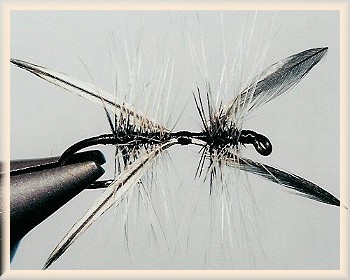Hard-Hackle Spider
By Richard Komar
Everyone is familiar with the foam rubber spider and
the soft-hackle spider, but it is time for a new
arachnid: The Hard-Hackle Spider!
The Hard-Hackle Spider is all-hackle and can be tied in
six easy steps. For predatory bass, it can be tied as
large as a size 2 to resemble a large, hairy tarantula
or as small as a size 14 to make a tantalizing little
floating morsel for wary bream and discriminating trout.
The use of good quality rooster cape hackle for the body
and legs gives the Hard-Hackle Spider that natural "hairy"
look and feel of a real arachnid. Even though any
high-quality hackle can be used, I prefer Conranch
rooster dry-fly hackle for its extra-stiff barbs that
allow my Hard-Hackle Spider to float high in the water
with its legs just above the surface.
Materials List:
Hook: Mustad 94840, size 4 to size 14; Mustad 3366 size 2.
Thread: Gudebrod 6/0, black.
Hackle: Rooster Cape, silver badger (or your choice color).
Legs: Rooster Cape, silver badger (or your choice color).
Instructions - The Hard-Hackle Spider:
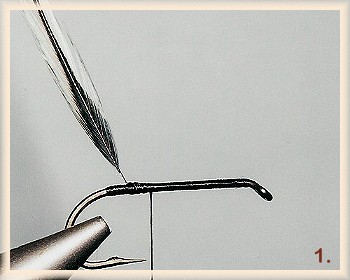
1. Lay a thread base along the entire length of the
hook shank. Tie in a rooster cape hackle by the stem,
dull side toward the hook eye. Wind the hackle about
1/3 up the hook shank and tie off. Wrap the thread
forward for another 1/3 of the shank to form the thin
thorax.
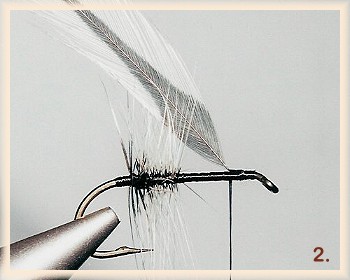
2. Tie in a second rooster cape hackle by the stem again,
dull side toward the hook eye. Wind forward, tie off,
and whip finish.
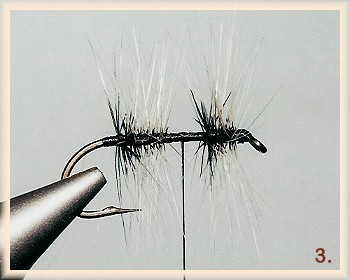
3. Reattach the thread in the center of the thorax.
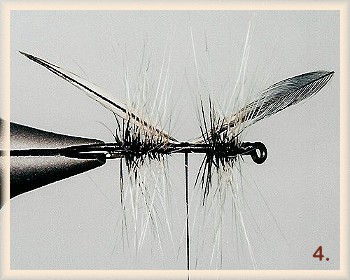
4. Prepare two hackle tips of equal length for the legs.
Attach one hackle tip to one side of the thorax with two
wraps of thread, tip pointing to the hook bend. The "hard"
hackle on either side will give the tip a natural vee
arachnid look.
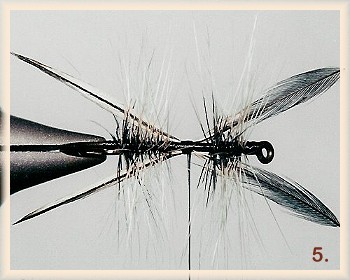
5. Attach the second "leg" to the other side of the thorax
with two wraps of thread, hackle tip pointing to the hook
bend. Gently pull on both "legs" toward the hook eye
until the "legs" are the length you prefer. Trim excess
hackle at the hook eye end to make the "legs" equal.
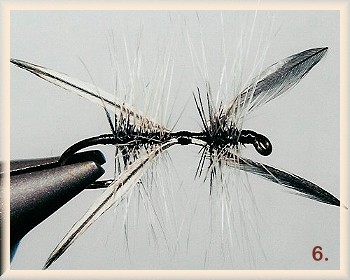
6. Tie off the thorax, making sure no "hard" body hackle
is trapped under the thread. Whip finish, splay out the
"legs" more if you desire and viola! The Hard-Hackle
Spider is ready to fish!
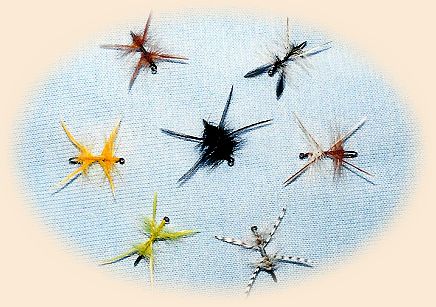
How to Fish the Hard-Hackle Spider:
Because it is tied with "hard" hackle versus "soft"
hackle, the Spider is ideally suited for top-water
duty. With the use of good quality "hard" hackle,
and a good floatant, the Spider will float tantalizingly
with its legs just barely suspended over the surface
(for that 3-D effect!). Use of oversized hackle is
preferred to give that "hairy" arachnid look.
In warmwater, fish it like a popper for bass. The large
hackle gives a very subtle gurgle when tugged gently.
Tied in yellow and chartruese, it will go head-to-head
with any rubber spider on the pond for bream.
In coldwater, fish it across & down, like a traditional
soft-hackle. Remember, you are covering the top-water
now where no soft-hackle ventures. Allow the Hard-Hackle
Spider to slowly get waterlogged, and it will start to
float in the film, and eventually start to sink ever so
slowly with its all-hackle body and hackle legs undulating
all the way down in the water column. Can't wait? Just
slide a small beadhead down your tippet. After all, a
spider that drops onto the water will not float forever!
And above all, don't be afraid to experiment with different
hackle colors and hook sizes. Tight Lines!
~ Richard
About Richard:
Richard Komar is a flyfisher and fly tyer in Plano, Texas.
He is a member of the FFF, ORCA, the Dallas FlyFishers,
the North Texas Fly Casting Club, the Texas WarmWater
FlyFishers and the Blue River Flyfishers. He enjoys
collecting vintage Pflueger fly reels and is the proud
owner of a folding boat.
|

